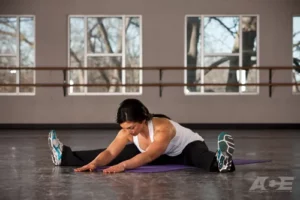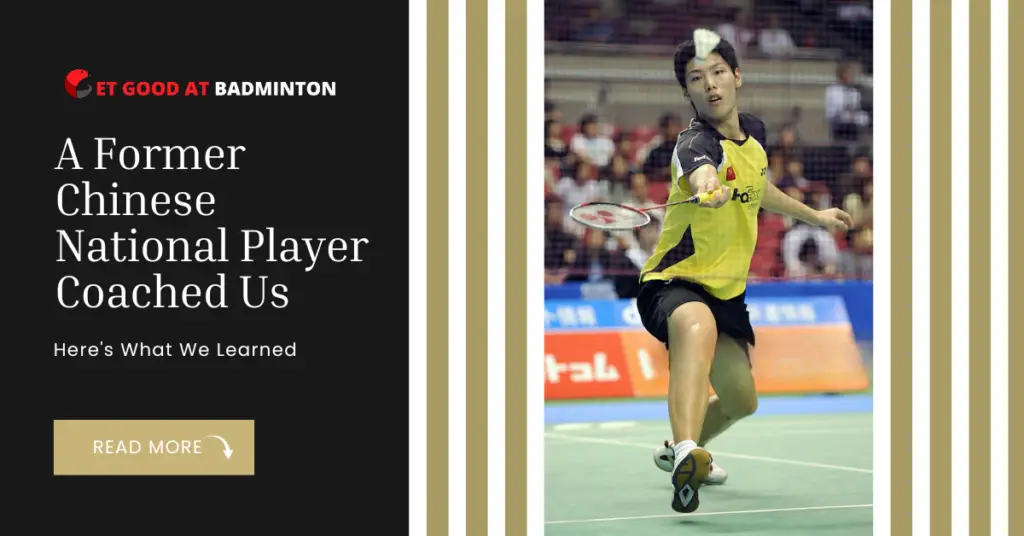On Monday, July 10, 2023, I had a phenomenal opportunity to join a training session led by former Chinese national men’s singles player Lü Yi whose highest ranking was 48th in the world and occupied the 3rd spot on the first Chinese national team.
Although this is a player you likely never have heard of, Lü Yi was a top-caliber player who could contest against other famous players like Taufik Hidayat and Boonsak Ponsana. He shared a vast amount of badminton knowledge that helped me a ton, and I’m hoping sharing what he taught us will also help you.
Train Your Mobility
Though Lü Yi did not talk about mobility specifically, this stood out right at the start when we were following his warm-up routine. The first thing we started with was a straddle stretch, and it was mindblowing to see how flexible Lü Yi was even though he was 38 years old.

Lü Yi was almost doing the splits while I couldn’t even get to a 45-degree angle despite being nearly 20 years younger. In fact, he was much more flexible than the entire class, even though the average age was around 14 years old.
Seeing Lü Yi’s flexibility made me realize how under-the-radar training your mobility goes. We spend so much time developing strength via weight training and high-intensity bodyweight exercises and playing the sport, and not enough time improving our muscle flexibility.
And it shows. The number of injuries I see in young badminton players is too high for their age and how much they train. It’s a problem if you’re getting injured training only twice a week at 14 years old.
I’ve been fortunate not to get injured, but that doesn’t mean I haven’t been affected. My lack of muscle flexibility shows in my gameplay. Whenever I need to stretch in uncomfortable positions or turn quickly, I often fail and lose the point.
My initial thought was to get stronger and faster so I don’t end up in uncomfortable positions, but now I realize that muscle and joint mobility play a crucial role in developing strength. Thus, I’ve added exercises to my warm-up and cooldown routines to help build mobility simultaneously and plan to add additional training sessions dedicated to building flexibility.
Badminton Mentality During Drills
What I loved about Lü Yi’s class was his pointers regarding mentality during training. I’m a huge believer that the key to improving starts with the way you think.
Lü Yi’s advice is to play like you’re in a game. He mentioned that when you’re in a game and make more than two mistakes in a row, it gets challenging to catch up. You don’t want to be in a situation where you’re trying to get three or more points in a row to catch up.
Thus, when you train, focus on making less than two mistakes consecutively and train your ability to reset mentally.
Another tip I got was during a 2-on-1 defense drill, where he told me to go for every shot and try to at least one-touch everything. That means running and diving for the shot regardless of how far away it is from you.
The idea is to make it difficult for your opponent to get points. When you make your opponents work extra hard and frustrate them, they’ll try to force better shots and become more likely to make mistakes.
Ultimately, the people that win in tournaments are the ones who can sustain themselves mentally and physically during difficult times. The way you train will directly reflect in your tournament play.
Some Notes On Technical
I was impressed by how great of a coach Lü Yi is. In just one session, we learned so much, not just about mentality but also about badminton technique.
The first drill was a simple single shuttle drive drill where we hit drives to a partner on a half-court. The tip he gave out here that I took to heart was whoever wins the drive battle is the one who can get ready the fastest, so we should all try to get our racket up as early as we can and focus on making quick swings.
After driving for 10 minutes, we did a variation of a drop-net drill that involved spin netting the block, spinning the spin, and lifting the spin net. I loved this drill because you got to practice hitting basic shots at the net in difficult situations. The better you get at spinning and lifting spins, the more comfortable you’ll be at controlling the net.
The advice Lü Yi gave to my brother while watching him do some drills was not to move your hand and arm when you play net shots at high speed. For example, if you play a drop and move at high speeds toward the net, you don’t need extra momentum from your hands to play a good spin.
The next drill after the drop-net drill was a 2-on-1 defense drill. I already talked about the mentality tip, but Lü Yi also gave me some technical advice. The main thing I learned was that if I had trouble getting my opponent’s smash, I could stand further back because as long as I got low, I had the power to push forward to defend against drops.
These were all small adjustments that greatly impacted our game, and I highly recommend you try to implement some of these lessons.
General Competition Mindset Advice
At the end of the training session, Lü Yi sat us down and discussed some more general mindset advice. These are lessons that aren’t necessarily new but always worth repeating over and over.
First, whoever wins isn’t necessarily the one with the best technique but who can last the longest. Whenever you’re under pressure or tired, think about all the time you spent practicing. Competition is a once-in-a-while thing while practice is ongoing. Your performance will be a direct reflection of how you practice.
The advice is very similar to the principles I follow to play at my best in tournaments.
Also, don’t compare yourself to others. Compare yourself to how you were six months ago, and that will continue motivating you to train harder. See yourself for how far you’ve come, and you’ll see you can go further.
Conclusion
And that’s all I have for today! I hope some of these lessons I learned from a former Top 50 player were helpful. What did you think? Let me know in the comment section below!

